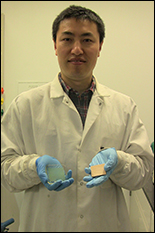A View Through Wood Shows Futuristic Applications
Researchers at the University of Maryland have made a block of linden wood transparent, which they say will be useful in fancy building materials and in light-based electronics systems. Materials scientist Liangbing Hu (also a member of the Maryland NanoCenter and the University of Maryland's Energy Research Center) and his team at the University of Maryland, College Park, have removed the molecule in wood—lignin—that makes it rigid and dark in color. They left behind the colorless cellulose cell structures, filled them with epoxy, and came up with a version of the wood that is mostly see-thru. They published their results today in the journal Advanced Materials. "It can be used in automobiles when the wood is made both transparent and high strength," said Dr. Mingwei Zhu, the co-first author of the paper, a visiting professor at the University of Maryland. "You could also use it as a unique building material." Remember "xylem" and "phloem" from grade-school science class? These structures pass water and nutrients up and down the tree. Hu and his colleagues see these as vertically aligned channels in the wood, a naturally-grown structure that can be used to pass light along, after the wood has been treated. The resulting three-inch block of wood had both high transparency—the quality of being see-thru—and high haze—the quality of scattering light. This would be useful, said Hu, in making devices comfortable to look at. It would also help solar cells trap light; light could easily enter through the transparent function, but the high haze would keep the light bouncing around near where it would be absorbed by the solar panel. They compared how the materials performed and how light worked its way through the wood when they sliced it two ways: one with the grain of the wood, so that the channels passed through the longest dimension of the block. And they also tried slicing it against the grain, so that the channels passed through the shortest dimension of the block. The short channel wood proved slightly stronger and a little less brittle. But though the natural component making the wood strong had been removed, the addition of the epoxy made the wood four to six times tougher than the untreated version. Then they investigated how the different directions of the wood affected the way the light passed through it. When laid down on top of a grid, both kinds of wood showed the lines clearly. When lifted just a touch above the grid, the long-channel wood still showed the grid, just a little bit more blurry. But the short channel wood, when lifted those same few millimeters, made the grid completely invisible. --end-- Highly Anisotropic, Highly Transparent Wood Composites Mingwei Zhu, Jianwei Song, Tian Li, Amy Gong, Yanbin Wang, Jiaqi Dai, Yonggang Yao, Wei Luo, Doug Henderson, Liangbing Hu Advanced Materials, 2016 DOI: http://dx.doi.org/10.1002/adma.201600427 The A. James Clark School of Engineering at the University of Maryland serves as the catalyst for high-quality research, innovation, and learning, delivering on a promise that all graduates will leave ready to impact the Grand Challenges (energy, environment, security, and human health) of the 21st century. The Clark School is dedicated to leading and transforming the engineering discipline and profession, to accelerating entrepreneurship, and to transforming research and learning activities into new innovations that benefit millions. Visit us online at www.eng.umd.edu and follow us on Twitter @ClarkSchool.
Related Articles: May 5, 2016 Prev Next |


